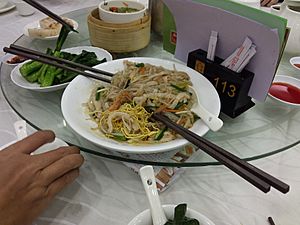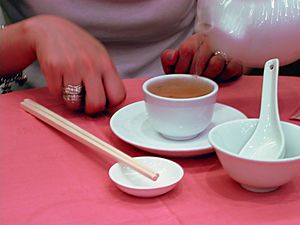Yum cha facts for kids
Quick facts for kids Yum cha |
|||||||||||||||||||||||||
|---|---|---|---|---|---|---|---|---|---|---|---|---|---|---|---|---|---|---|---|---|---|---|---|---|---|

Yum cha at Hong Kong City Hall
|
|||||||||||||||||||||||||
| Traditional Chinese | 飲茶 | ||||||||||||||||||||||||
| Simplified Chinese | 饮茶 | ||||||||||||||||||||||||
| Literal meaning | drink tea | ||||||||||||||||||||||||
|
|||||||||||||||||||||||||
Yum cha is a fun Cantonese tradition. It's like a special brunch that includes Chinese tea and delicious dim sum dishes. This practice is very popular in places where people speak Cantonese. These areas include Guangdong and Guangxi provinces, Hong Kong, and Macau. You can also find yum cha in other parts of the world. Many Cantonese communities abroad enjoy this tradition.
Yum cha usually means eating small portions of dim sum. These dishes can be steamed, pan-fried, or deep-fried. They are often served in bamboo steamers. People share these dishes and drink hot tea with their meal. Families and friends often go to yum cha together for gatherings and celebrations.
Contents
What is Yum Cha?
Yum cha (traditional Chinese: 飲茶; simplified Chinese: 饮茶; Mandarin Pinyin: yǐn chá; Jyutping: jam2 caa4; Cantonese Yale: yám chà) means "drink tea" in Cantonese. It is also called "going for dim sum" (Cantonese: 食點心). It is a special meal that combines Chinese tea with dim sum dishes. This tradition is very common in Cantonese-speaking areas. These include Guangdong, Guangxi, Hong Kong, and Macau. You can also find yum cha in other countries. Places like Vietnam, Australia, and the United States have Cantonese communities that enjoy it.
Yum cha meals usually have small servings of dim sum. These dishes are often steamed, pan-fried, or deep-fried. They come in bamboo steamers. People share these dishes and drink hot tea. Traditionally, older people might eat dim sum after their morning exercises. Many families enjoy yum cha together on weekends and holidays.
The Meaning of Yum Cha
The words yum cha in Cantonese literally mean "drink tea." "飲" means "to drink," and "茶" means "tea." Sometimes, people also say tan cha (嘆茶). This means "enjoy tea."
In Cantonese, yum cha means having a meal with dim sum dishes. The English word dim sum comes from a Cantonese pronunciation of 點心. In Chinese, 點心 can mean many different foods. This includes cakes and pastries from Europe. There isn't one perfect English word for it.
In English, dim sum usually refers to small appetizers and desserts. In Australia, "yum cha" often means Cantonese restaurants that serve dim sum from push carts. They don't usually offer an à la carte menu.
How Yum Cha is Served
Traditionally, yum cha happens in the morning or early afternoon. So, it's sometimes called zou cha (早茶, "morning tea"). Or, if it's later, ha ng cha (下午茶, "afternoon tea"). In some parts of Guangdong, restaurants serve dim sum for dinner or late at night. This is called yum je cha (飲夜茶, "drinking night tea"). But most places still serve dim sum for breakfast and lunch.
The history of yum cha goes back to the Xianfeng Emperor. He called places that served tea yi li guan (一釐館, "1 cent house"). These were places where people could chat, which was called cha waa (茶話, "tea talk"). These tea houses grew into restaurants. Visiting them became known as yum cha.
Servers traditionally brought dim sum on trays around their necks or on push carts. The teoi ce (推車, "push-cart") way of serving started in the 1960s. Dim sum items were cooked ahead of time. They were put into steamer baskets and brought to the dining area on carts. Employees would call out the dishes they had. Customers would tell the server what they wanted. The server would then place the dishes on the table. The yum cha atmosphere is usually loud and lively. This is because servers call out dishes and diners chat.
Many dim sum restaurants now use paper menus for ordering. This is an à la carte system. This way, the dim sum is cooked fresh when you order it. It also helps restaurants save space and resources.
In the past, the cost of a meal was figured out by counting the dishes left on the table. Today, servers mark a card or bill on your table. Some restaurants use special stamps. This helps them track what each server sells.
Yum Cha Customs
There are some special customs about the tea served at yum cha:
- When you sit down, you choose the type of tea you want.
- Pour tea for others before filling your own cup. Younger people should pour for older people first. This shows politeness.
- Fill tea cups about 80% full. There's a Cantonese saying: "It is fraud for the guest if the tea cup is full, but it is a sign of respect when it is alcohol."
- Tap the table with two (or sometimes one) finger. This is called 'finger kowtow'. It's a way to say thank you when someone pours you tea. This custom comes from the Qianlong Emperor of the Qing dynasty. He used to travel secretly. Once, he poured tea for his friends. They wanted to bow to thank him, but that would have shown who he was. So, one friend tapped three fingers on the table. One finger was like their bowed head, and two were like their arms.
- If your teapot is empty, open the lid or move the cover. This signals to the server that you need a refill.
- It's a tradition to wash your utensils with the first round of tea. This also warms the cup. A basin is provided for the rinse tea. The first tea is not considered the best. The tea tastes richer after this first rinse.
Here are some customs for diners:
- Try to pick a table close to the kitchen. The dim sum carts come out from there. So, you get the first choice of fresh dishes!
- You can order dessert dishes from the carts at any time. There's no set order for the meal.
- It's okay to say no to dishes offered by servers. You can decline for any reason. This includes diet, food preference, or budget.

When eating, here are some manners to remember:
- Spin the lazy susan so the oldest person at the table gets the first serving. This shows respect. Don't spin it when someone is taking food from a dish.
- Don't stand chopsticks straight up in rice or buns. This looks like incense offerings for people who have passed away.
- Offer the last piece of a dish to your dining companions.
- It's common to insist on paying the bill. People often like to treat each other to meals.
- If there is no lazy susan, only take food that is directly in front of you.
Yum Cha Today
Yum cha is still very popular. You can find both traditional and modern restaurants. Some places even serve "fusion" dim sum. This might include fancy dishes like abalone siu mai or barbecued wagyu beef buns. Chefs still train at top cooking schools to make dim sum. One restaurant in Hong Kong makes dumplings and buns shaped like animals. These are popular for social media! Whether old-fashioned or new, yum cha is always meant to be shared with friends and family.
See Also
 In Spanish: Yum cha para niños
In Spanish: Yum cha para niños







